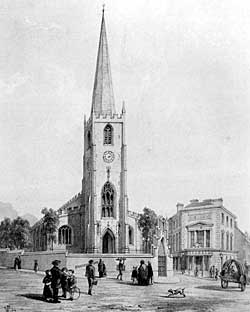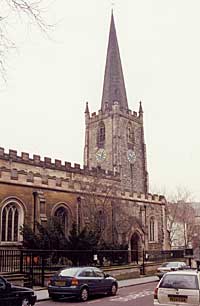< Previous | Contents | Next >
St Peter's Church
ST. PETER'S CHURCH.

St Peter's Church in the mid-19th century. The old Post Office is on the right.
St. Peter's Church is an imposing medieval structure left as an island in the midst of the turmoil of modern civilisation. Mr. Guilford says that its proper dedication is to St. Peter and St. Paul, which dedication is of extreme antiquity, witness the joint monastery of St. Peter and St. Paul founded at Jarrow and Monkwear-mouth by Benedict Biscop in 685. There is, however, no trace of a pre-Conquest church on the site of St. Peter's, Nottingham, nor indeed are there any remains of Norman workmanship to be found in the building. The first reference that we have to it is that its living was granted by Peveril to the Prior and Convent of Lenton Priory when he established that monastery between the years 1103 and 1108. I think we must be content to believe that it, together with St. Nicholas formed the two churches in the French Borough and that possibly St. Nicholas would have something of the flavour of a court chapel about it and would be the church resorted to by the governor of the castle and his entourage, while St. Peter's might possibly be the church of the burghers of the French town.
The building consists of a nave with north and south aisles, a north porch, a tower surmounted by a spire, and a chancel, and of these buildings the south arcade of the aisles is the earliest portion. It is a fairly good example of the Early English style of architecture and belongs to the concluding years of the reign of Henry II, sometime about 1180. Although its age has given it a certain picturesqueness there is nothing particularly striking about this arcade nor can it for a moment compare in architectural interest to the later work in St. Mary's Church.
The north arcade is of the 14th century and has been so much mutilated by the introduction and the withdrawal of galleries and so forth that it is really of very little importance. It is probably contemporary with Richard II. and is a little later than the "Salutation Inn" in Houndsgate.
 St Peter's Church from St Peter's Street before
cleaning and restoration work in 2003 (A Nicholson, 2001).
St Peter's Church from St Peter's Street before
cleaning and restoration work in 2003 (A Nicholson, 2001).The roof and the nave and the south aisle although very much restored still retain the old designs. They were a gift of the Strelley family in the 15th century. The roof of the north aisle is modern. In ancient days there were various chapels and altars in the church, the site of only two of which have been identified. St. George's Chapel was in the north aisle where the organ now stands, St. Mary's Chapel was in the south aisle. In 1315 there is a curious note in the Borough Records of a grant "by the service of keeping a lamp burning before the altar of St. Lawrence in St. Peter's Church, Nottingham," and there is also mentioned about the same time a chapel of All Saints, but where these were it is now impossible to say.
The south aisle was used as a Consistory Court during the Middle Ages and many of the records of this court remain, much interest being extracted from them and published in the Transactions of the Thoroton Society by Colonel Hodgkinson. A well-preserved rood stair remains to the south of the chancel arch and is curious from the fact that at its upper end an altar has been discovered, but whether this is the high altar of the old church or some other altar is unknown. It is curious to notice that both the chancel arch and the tower arch are not squarely centred with the nave and this has led to considerable difficulties in maintaining proper balance during modern restorations.
The chancel itself is quite modern and has succeeded to one which was erected during the Civil Wars. It appears that St. Peter's Church was a danger point and suffered from bombardment during which the medieval chancel was completely destroyed. It must have been restored pretty quickly for when St. Nicholas Church was pulled down in 1647, owing to the danger of its proximity to the castle, the congregation thus displaced was accommodated in a loft prepared for them over this chancel. The outer walls of the aisles were rebuilt in the early part of the 19th century, the southern aisle being rebuilt in 1800 and the north in 1806 and to this date I think we may assign the wretched clerestory windows. There are thus many restorations in St. Peter's Church, but until modern times they have not been undertaken in any scientific spirit, however, use has been made of most unsightly Roman cement, brick stucco and other mean materials, so that the beauties of St. Peter's Church have been very much diminished.
